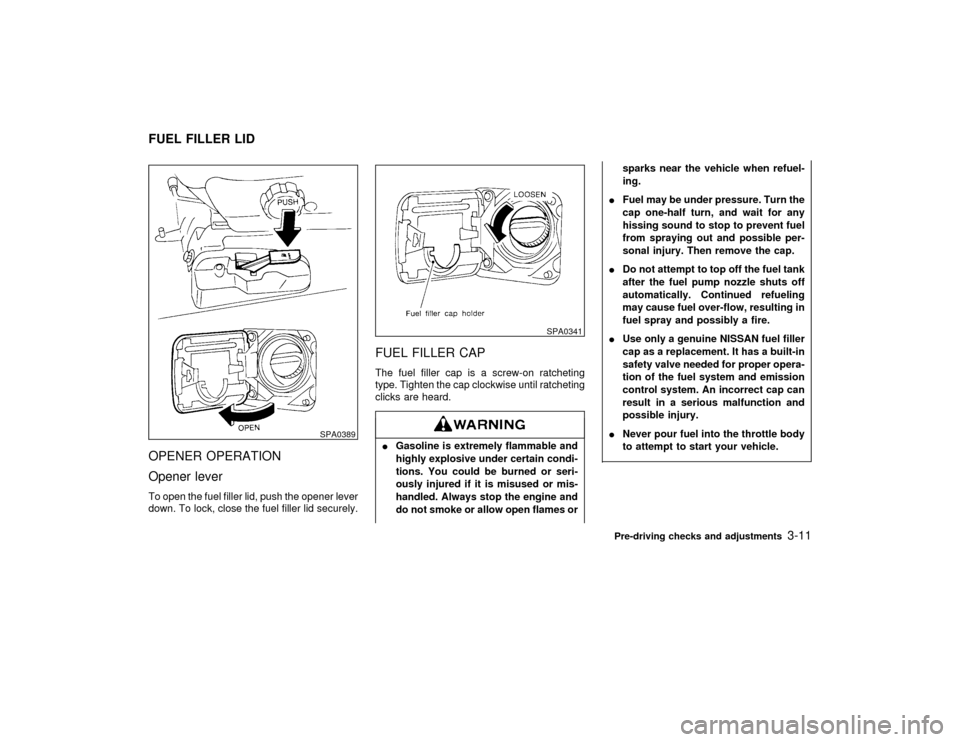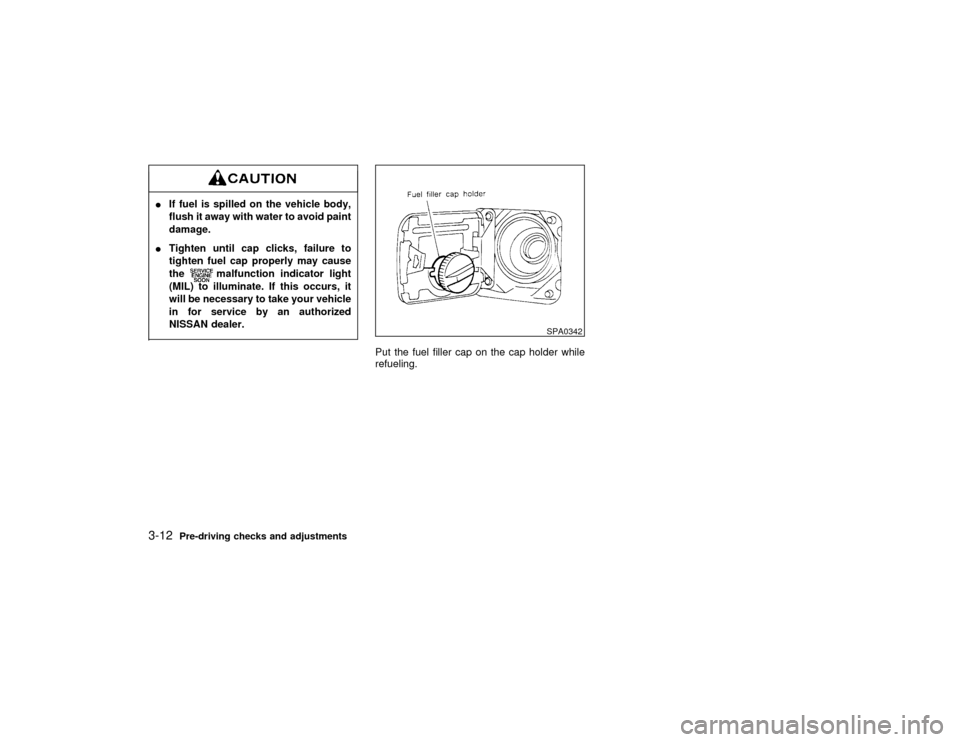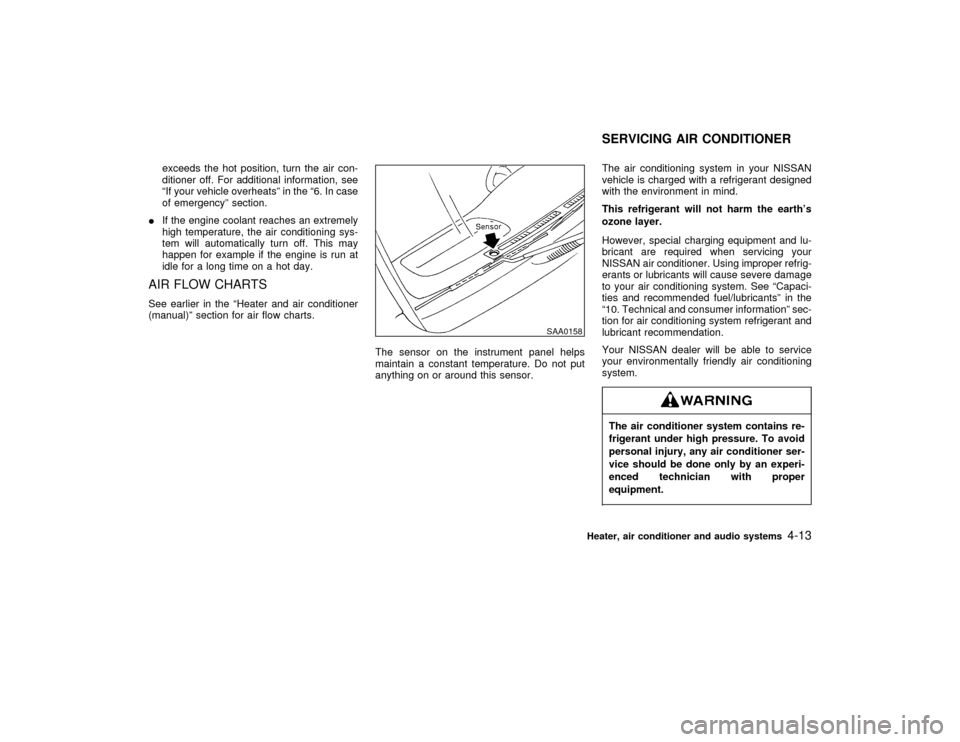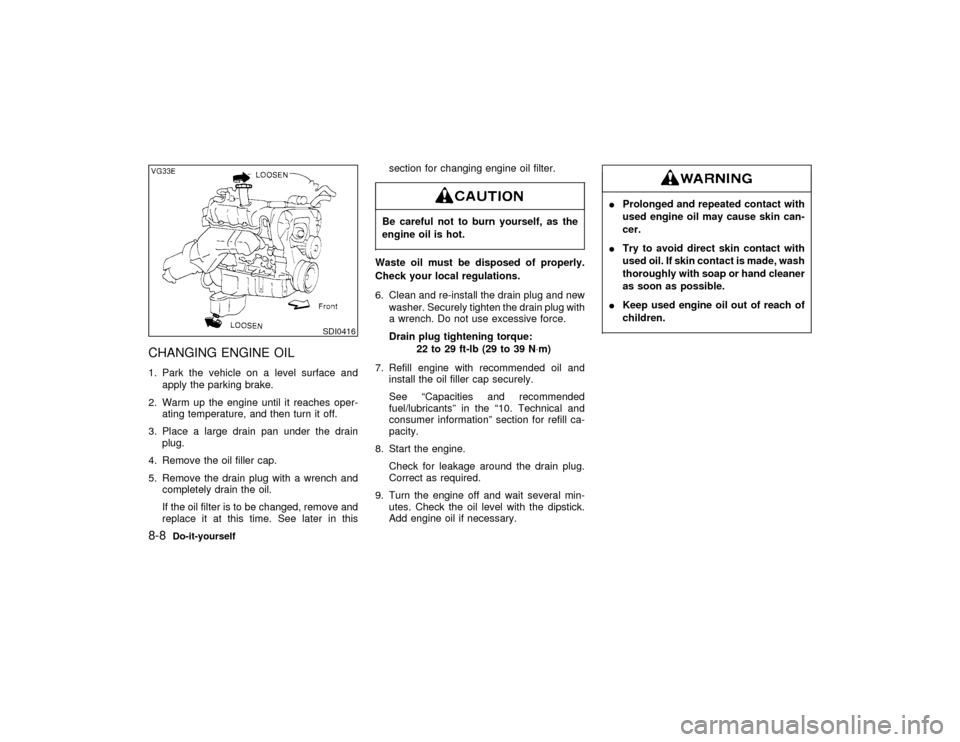1998 NISSAN PATHFINDER fuel cap
[x] Cancel search: fuel capPage 58 of 249

being hauled or towed.
The malfunction indicator light may stop blink-
ing and come on steady.
Have the vehicle inspected by an authorized
NISSAN dealer. You do not need to have your
vehicle towed to the dealer.
Continued vehicle operation without
having the emission control system
checked and repaired as necessary
could lead to poor driveability, reduced
fuel economy, and possible damage to
the emission control system.Some conditions may cause the malfunction
indicator light to come on steady or blink.
Examples are as follows:
Ivehicle ran out of fuel, which caused the
engine to misfire.
Ifuel filler cap was left off or improperly
installed, allowing fuel to evaporate into the
atmosphere.
If you suspect that you experienced one or
both of the above conditions, drive the vehicle
to an authorized NISSAN dealer and have thevehicle inspected. Avoid any unnecessary di-
agnosis during the service by informing the
dealer of the conditions listed above that may
have occurred.
Four wheel drive indicator
light
This light comes on when the transfer shift
control lever is in the 4H or 4L position.BUZZERS
Key reminder buzzerThe buzzer will sound when the driver side
door is opened if the key is left in the ignition
switch. Take the ignition key when you leave
the vehicle.Light reminder buzzerA buzzer will sound if the driver's door is
opened with the light switch on unless the
ignition key in the ON position. Turn the light
switch off when you leave the vehicle.Brake pad wear warningThe disc brake pads have audible wear warn-
ings. When a brake pad requires replacement,
it will make a high pitched scraping sound.
Have the brakes checked as soon as possible
if the warning sound is heard when the vehicleis moving, whether or not the brake pedal is
depressed.
Instruments and controls
2-13
Z
01.1.31/R50-D
X
Page 96 of 249

OPENER OPERATION
Opener leverTo open the fuel filler lid, push the opener lever
down. To lock, close the fuel filler lid securely.
FUEL FILLER CAPThe fuel filler cap is a screw-on ratcheting
type. Tighten the cap clockwise until ratcheting
clicks are heard.IGasoline is extremely flammable and
highly explosive under certain condi-
tions. You could be burned or seri-
ously injured if it is misused or mis-
handled. Always stop the engine and
do not smoke or allow open flames orsparks near the vehicle when refuel-
ing.
IFuel may be under pressure. Turn the
cap one-half turn, and wait for any
hissing sound to stop to prevent fuel
from spraying out and possible per-
sonal injury. Then remove the cap.
IDo not attempt to top off the fuel tank
after the fuel pump nozzle shuts off
automatically. Continued refueling
may cause fuel over-flow, resulting in
fuel spray and possibly a fire.
IUse only a genuine NISSAN fuel filler
cap as a replacement. It has a built-in
safety valve needed for proper opera-
tion of the fuel system and emission
control system. An incorrect cap can
result in a serious malfunction and
possible injury.
INever pour fuel into the throttle body
to attempt to start your vehicle.
SPA0389
SPA0341
FUEL FILLER LID
Pre-driving checks and adjustments
3-11
Z
01.1.31/R50-D
X
Page 97 of 249

IIf fuel is spilled on the vehicle body,
flush it away with water to avoid paint
damage.
ITighten until cap clicks, failure to
tighten fuel cap properly may cause
the
malfunction indicator light
(MIL) to illuminate. If this occurs, it
will be necessary to take your vehicle
in for service by an authorized
NISSAN dealer.
Put the fuel filler cap on the cap holder while
refueling.
SPA0342
3-12
Pre-driving checks and adjustments
Z
01.1.31/R50-D
X
Page 114 of 249

exceeds the hot position, turn the air con-
ditioner off. For additional information, see
ªIf your vehicle overheatsº in the ª6. In case
of emergencyº section.
IIf the engine coolant reaches an extremely
high temperature, the air conditioning sys-
tem will automatically turn off. This may
happen for example if the engine is run at
idle for a long time on a hot day.
AIR FLOW CHARTSSee earlier in the ªHeater and air conditioner
(manual)º section for air flow charts.
The sensor on the instrument panel helps
maintain a constant temperature. Do not put
anything on or around this sensor.The air conditioning system in your NISSAN
vehicle is charged with a refrigerant designed
with the environment in mind.
This refrigerant will not harm the earth's
ozone layer.
However, special charging equipment and lu-
bricant are required when servicing your
NISSAN air conditioner. Using improper refrig-
erants or lubricants will cause severe damage
to your air conditioning system. See ªCapaci-
ties and recommended fuel/lubricantsº in the
ª10. Technical and consumer informationº sec-
tion for air conditioning system refrigerant and
lubricant recommendation.
Your NISSAN dealer will be able to service
your environmentally friendly air conditioning
system.
The air conditioner system contains re-
frigerant under high pressure. To avoid
personal injury, any air conditioner ser-
vice should be done only by an experi-
enced technician with proper
equipment.
SAA0158
SERVICING AIR CONDITIONER
Heater, air conditioner and audio systems
4-13
Z
01.1.31/R50-D
X
Page 183 of 249

CHANGING ENGINE OIL1. Park the vehicle on a level surface and
apply the parking brake.
2. Warm up the engine until it reaches oper-
ating temperature, and then turn it off.
3. Place a large drain pan under the drain
plug.
4. Remove the oil filler cap.
5. Remove the drain plug with a wrench and
completely drain the oil.
If the oil filter is to be changed, remove and
replace it at this time. See later in thissection for changing engine oil filter.
Be careful not to burn yourself, as the
engine oil is hot.Waste oil must be disposed of properly.
Check your local regulations.
6. Clean and re-install the drain plug and new
washer. Securely tighten the drain plug with
a wrench. Do not use excessive force.
Drain plug tightening torque:
22 to 29 ft-lb (29 to 39 N×m)
7. Refill engine with recommended oil and
install the oil filler cap securely.
See ªCapacities and recommended
fuel/lubricantsº in the ª10. Technical and
consumer informationº section for refill ca-
pacity.
8. Start the engine.
Check for leakage around the drain plug.
Correct as required.
9. Turn the engine off and wait several min-
utes. Check the oil level with the dipstick.
Add engine oil if necessary.
IProlonged and repeated contact with
used engine oil may cause skin can-
cer.
ITry to avoid direct skin contact with
used oil. If skin contact is made, wash
thoroughly with soap or hand cleaner
as soon as possible.
IKeep used engine oil out of reach of
children.
SDI0416
8-8
Do-it-yourself
Z
01.1.31/R50-D
X
Page 220 of 249

10 Technical and consumer informationCapacities and recommended fuel/lubricants ......... 10-2
Specifications .......................................................... 10-9
Tires and wheels ................................................... 10-10
When traveling or registering your
vehicle in another country ..................................... 10-11
Vehicle identification ............................................. 10-12
Vehicle loading information ................................... 10-14
Towing a trailer ..................................................... 10-15
Emission control system warranty ........................ 10-19
Reporting safety defects (US only) ....................... 10-19
Readiness for inspection/
maintenance (I/M) test (US only) .......................... 10-20
Z
01.1.31/R50-D
X
Page 221 of 249

The following values are approximate capacities. The actual refill capacities may be a little different from them. When refilling, follow the
procedure instructed in the ª8. Do-it-yourselfº section to determine the proper refill capacity.
Capacity (Approximate)
Recommended specifications
US
measureImp
measureLiter
Fuel 21-1/8 gal 17-5/8 gal 80Unleaded gasoline with an octane rating
of at least 87 AKI (RON 91)*1
Engine oil (Refill)
with oil filter 3-7/8 qt 3-1/4 qt 3.7IAPI SG or SH and Energy Conserving
II*2 *3
IAPI Certification Mark*2 *3 without oil filter 3-5/8 qt 3 qt 3.4
Cooling system
(with heater and
reservoir tank)11-1/4 qt 9-3/8 qt 10.6Anti-freeze coolant
(Ethylene glycol base)
*1: See later in this section for fuel recommendation.
*2: See later in this section for recommended SAE viscosity number.
*3: See later in this section for engine oil and oil filter recommendation.CAPACITIES AND
RECOMMENDED
FUEL/LUBRICANTS10-2
Technical and consumer information
Z
01.1.31/R50-D
X
Page 242 of 249

11 Index
A
ABS ................................................................. 5-25
Adjusting the time ........................................... 2-33
Adjustment
Front manual seat ....................................... 1-2
Front power seat ......................................... 1-4
Head restraint .............................................. 1-8
Rear seat ..................................................... 1-5
Shoulder belt ............................................. 1-22
Air bag
System....................................................... 1-13
Warning label ............................................ 1-15
Warning light .................................... 1-15, 2-10
Air cleaner....................................................... 8-16
Air conditioner
Manual ......................................................... 4-3
Operation, Manual ....................................... 4-5
Operation, Semiautomatic ......................... 4-11
Semiautomatic ............................................. 4-9
Servicing .................................................... 4-13
Specification label ................................... 10-14
Air conditioning system refrigerant and
lubricant recommendations ............................. 10-8
Aluminum alloy wheels, Cleaning ..................... 7-3
Anchor point location, Top strap..................... 1-35
Antenna........................................................... 4-25
Anti-freeze, Cold weather ............................... 5-26
Anti-lock Brake System (ABS) ........................ 5-25Appearance care
Exterior ........................................................ 7-2
Interior ......................................................... 7-4
Armrest ............................................................. 1-8
Ashtray ............................................................ 2-22
Audio system .................................................. 4-14
Automatic
Sunroof, Operation .................................... 2-32
Transmission fluid ....................................... 8-9
Transmission, Driving .................................. 5-9
Avoiding collision and rollover .......................... 5-4
B
Back door.......................................................... 3-9
Battery
Cold weather ............................................. 5-26
Maintenance .............................................. 8-13
Replacement, Multi-remote control ............. 3-6
Before starting the engine ................................ 5-8
Belt
Drive .......................................................... 8-14
Extender, Seat........................................... 1-25
Height adjustment, Shoulder ..................... 1-22
Maintenance, Seat .................................... 1-25
Seat ........................................................... 1-17
Brake
Booster ...................................................... 8-19
Fluid ........................................................... 8-11Parking ...................................................... 5-15
Pedal ......................................................... 8-18
System....................................................... 5-24
Warning light ............................................. 2-10
Break-in schedule ........................................... 5-18
Bulb
Checking...................................................... 2-9
Indicator ..................................................... 2-12
Replacement ............................................. 8-22
Warning light ............................................... 2-9
Buzzer ............................................................. 2-13
C
Capacities and recommended fuel/lubricant .. 10-2
Car phone ....................................................... 4-26
Carbon monoxide, Exhaust gas ....................... 5-2
Cassette tape player operation....................... 4-16
Cassette tape player operation, with
compact disc (CD) player type ....................... 4-22
Catalytic converter, Three way catalyst............ 5-3
CB radio or car phone .................................... 4-26
Certification label, F.M.V.S.S. ....................... 10-13
Chain, Tire ...................................................... 8-27
Changing
A flat tire ...................................................... 6-2
Engine coolant............................................. 8-5
Engine oil..................................................... 8-8
Engine oil filter............................................. 8-9
Tire and wheel........................................... 8-28
Z
01.1.31/R50-D
X